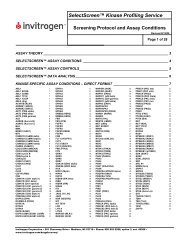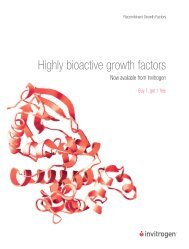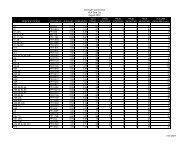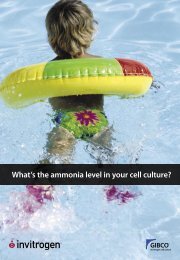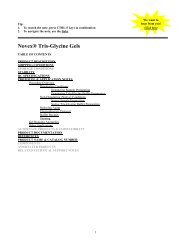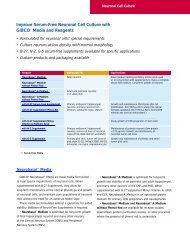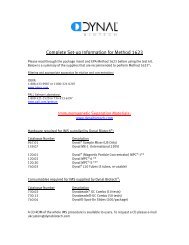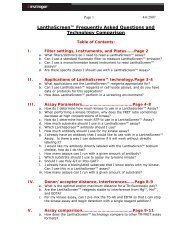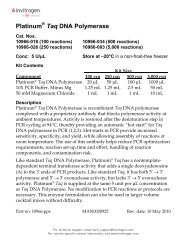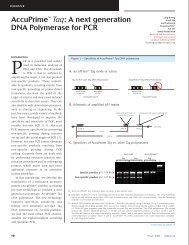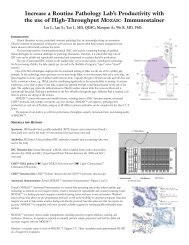TRIzol Reagent - Invitrogen
TRIzol Reagent - Invitrogen
TRIzol Reagent - Invitrogen
Create successful ePaper yourself
Turn your PDF publications into a flip-book with our unique Google optimized e-Paper software.
Isolation of RNA from Small Quantities of Tissue (1 to 10 mg) or Cells (100 to 10,000) Samples<br />
(back to Table of Contents)<br />
(back to Protocol and Application Notes)<br />
(back to RNA Isolation)<br />
Protocol:<br />
1. Add 800 µl <strong>TRIzol</strong> to the sample. Homogenize cells by pipetting repeatedly. Add 200 µg glycogen (Cat. No. 10814-010)<br />
directly to the <strong>TRIzol</strong> reagent. If processing tissue, pulverize in liquid nitrogen first and then add 800 µl <strong>TRIzol</strong><br />
containing 200 µg glycogen (final concentration 250 µg/ml) followed by vigorous vortexing or power homogenization.<br />
2. Place at room temperature, cap vial, and vortex at high speed for 10 sec. Make sure the <strong>TRIzol</strong> reagent wets the side of<br />
the vial in order to solubilize any sample that may be remaining on the walls.<br />
3. Shear the genomic DNA in the sample by passing twice through a 26-gauge needle connected to a 1 ml syringe. Using the<br />
syringe, transfer the sample to a sterile 1.5 ml microcentrifuge tube.<br />
4. Add 160 µl of chloroform (or 49:1 chlorform:isoamyl alcohol) to each sample and vortex up to 30 s. Spin at maximum<br />
speed in the microcentrifuge 5 minutes to separate the phases.<br />
5. Transfer the upper aqueous phase to a fresh tube and add 400 µl ice-cold isopropanol. Allow the samples to precipitate at<br />
-20 o C 1 hour - overnight. Pellet the RNA by centrifugation at maximum speed in the microfuge 15 min at room<br />
temperature.<br />
6. Decant the supernatant. Wash the pellet in 200 µl of 70% ethanol and spin again 10 min at maximum speed. Decant the<br />
supernatant, removing as much as possible without disturbing the pellet. Dry RNA pellet.<br />
7. Resolubilize the pellet in 30 - 50 µl RNAse-free deionized water. NOTE: If tissue is high in RNAses (e.g., adrenal gland,<br />
pancreas,) resuspend in 100% deionized formamide. Be sure to vortex or pipette up and down the sample to ascertain that<br />
pellet is resolubilized fully. Store at -70 o C.<br />
Note: The glycogen remains in the aqueous phase and is co-precipitated with the RNA. It does not inhibit first-strand<br />
synthesis at concentrations up to 4 mg/ml and does not inhibit PCR. Nanogram amounts of total RNA can be obtained from<br />
as little as 100 cells. Microgram amounts of total RNA were isolated from 1 to 10 mg of tissue. Decreasing the concentration<br />
of glycogen below 250 µg/ml <strong>TRIzol</strong> resulted in lower and more variable yields of RNA.<br />
Reference for Protocol: (Alma M. Bracete, Donna K. Fox, and Domenica Simms, 1998, Isolation and Long Term Storage of<br />
RNA from Ribonuclease-rich Pancreas Tissue, FOCUS ® 20:3, p. 82).<br />
Procedure for use when DNA is not needed, only RNA<br />
(back to Table of Contents)<br />
(back to Protocol and Application Notes)<br />
(back to RNA Isolation)<br />
When isolating RNA with <strong>TRIzol</strong>, if you do not need to isolate the genomic DNA, centrifuge the sample following<br />
homogenization before adding chloroform at 12000 X g for 10 minutes at 4ºC to pellet the DNA. Add chloroform to the<br />
supernatant and proceed with the RNA isolation protocol. Also, after RNA isolation, you can treat with Amplification Grade<br />
DNase I. Using non-amplification grade DNase I has been shown to degrade RNA samples in some cases.<br />
Expected A260/A280 of total RNA isolated by <strong>TRIzol</strong><br />
(back to Table of Contents)<br />
(back to Protocol and Application Notes)<br />
(back to RNA Isolation)<br />
The value of the A260/A280 ratio is a commonly used criteria for nucleic acid purification and the values usually given for pure<br />
DNA and RNA are 1.8 and 2.0, respectively (1-2). However, the absorbance of nucleic acids at these wavelengths is dependent<br />
upon the ionic strength and pH of the medium. For example, the A260/A280 ratio of the same RNA preparation differs greatly<br />
depending on whether the RNA is diluted into distilled, DEPC-treated water or TE (10 mM Tris-Cl, pH 8.0, 1 mM EDTA). When<br />
the RNA is diluted into and blanked against water the A260/A280 ratio is 1.7-1.8; when TE is used the ratio becomes 2.2-2.3. (Table<br />
from Fox, D.K. (1998) Focus 20.2, 37; Measuring Absorbance of RNA Samples)<br />
Diluent A260 A280 A260/A280 [RNA]µg/ml<br />
Cytoplasmic RNA 0.381 0.223 1.711 15.24<br />
12



